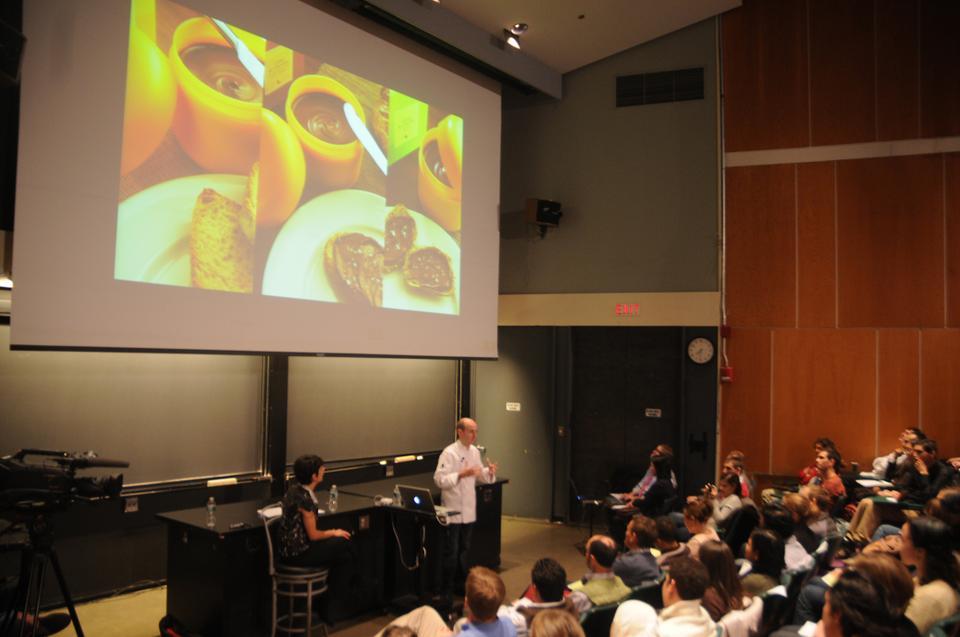
Need Sponsorship? Go Fish.
How do you get 300 servings of fresh sashimi-grade tuna, for free? On a campus bereft of even hot breakfasts, this might seem like a impossible task. But it turns out that the answer is laughably simple: just start one of the year’s most popular Gen Ed courses.
Science of the Physical Universe 27: Science of Cooking is indeed one of the most populated, glamorous and exclusive courses of those offered this year. It’s no surprise; celebrated chefs come in weekly to guest lecture, you get to eat your labs, and did we mention that it’s a Gen Ed science course about food? But with the creation of such a class came a whole host of logistical challenges, even beyond the very visible one of managing the lines for the public lectures. In addition to flying chefs in from around the world, the course’s organizers needed food-friendly labs, and, well, food.
However, with no slackening of the ambition that got such a class started in the first place, its creators set out to do the unheard of: get a free lunch, gourmet style. Even they admitted the uniqueness of this route: “It’s fairly normal to have a professor’s lab or research sponsored by grants, for example, but this is the first time I’ve ever heard of a class being sponsored, especially an undergraduate one,” said David A. Weitz, a physics professor and one of the course’s founders. But in the end it got done, with Whole Foods providing the victuals, Cole Parmer much of the lab’s cooking equipment, Alicia Foundation most of the chemicals needed for the labs, and other companies, such as Mars, providing financial support.
But how was the Science of Cooking team able to get so many big players on board? “First of all, it’s Harvard. And it’s new. And furthermore, they’re able to get their names associated with these chefs,” said Christina M. Andujar, a faculty administrator in the School of Engineering and Applied Sciences (SEAS) who was responsible for much of the contact with the course’s sponsors. “This is pop culture now. Ten or fifteen years ago no one watched cooking shows, and the course probably wouldn’t have been as popular as it is today.”
“I suspect they like seeing their logo at the public lectures, which are wildly popular,” said Naveen N. Sinha, head teaching fellow of the class.
Each sponsor had its own more nominal priorities coming into the term, however. Some emphasized their eagerness to be part of such a large-scale effort at culinary education. The Alicia Foundation, an institute for science and cooking research led by Ferran Adria, even supplied the course’s organizers with lists of questions for students to try and answer for their final projects, the same sort of questions that the Alicia foundation researches. “Alicia has been instrumental not just for financial, but also for intellectual support,” said Michael P. Brenner, professor of Applied Mathematics and Applied Physics, and another of the course’s founders.
Some of the course’s sponsors more directly pointed to the contact with celebrity chefs that would come of their association with the well-connected class. Cole Parmer, a Chicago-based company, was especially excited for the connection with Grant Achatz of the restaurant Alinea, in Chicago, while Mars representatives came to visit for Enric Rovira, the course’s guest chocolatier.
Whole Foods, which now makes weekly deliveries to the lab, also echoed the educational motivation of supporting the class. “The course matches what we are trying to do in educating people about food,” said David Remillard, of the Whole Foods on River Street in Cambridge, who serves as Whole Foods’ liaison with the course, communicating directly with Sinha about the lab’s weekly orders. “We partner with community kitchens, and, for example, with the Cambridge Culinary School, but this is unique in my tenure, to be partnering with an undergraduate course,” he said.
Unique as it may be, the relationship seems to be working well on both ends. “They’ve been quite accommodating; when we needed to switch the recipe at the last minute to use more salt, we were able to switch it easily,” said Sinha. “Accommodating” is perhaps a slight understatement, as the gestures of these sponsorships take on a whole new magnitude when the sheer scale of the operation is considered. According to Brenner, last week’s order for supplies included 300 eggs, 20 pounds of sugar, chocolate chips and butter, and 10 pounds of flour, all of which went towards making a molten chocolate cake and accompanying ice cream. Not to mention the sashimi sushi of the week before.
Perhaps largest of all, however, was the donation of the food-safe lab space that allowed the delicious cake and ceviche to avoid being, say, corroded by Acetone. Thanks to the new Northwest Laboratories, the class was actually able to get unused labs for the class, a quite generous contribution when you consider that to stay food-safe, the labs cannot be used for anything else. “If they used it for another class, it would be hard to get it back to being safe for food; but I’d venture to say that this class isn’t going anywhere,” said Andujar. Start thinking about your bribe for next year’s lottery. Your average chocolate chip cookies probably won’t do.


